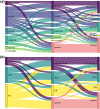Effects of a reduction of the number of electrodes in the EEG montage on the number of identified seizure patterns
- PMID: 35301386
- PMCID: PMC8930978
- DOI: 10.1038/s41598-022-08628-9
Effects of a reduction of the number of electrodes in the EEG montage on the number of identified seizure patterns
Abstract
Continuous EEG monitoring (cEEG) is frequently used in neurocritical care. The detection of seizures is one of the main objectives. The placement of the EEG electrodes is time consuming, therefore a reduced montage might lead to an increased availability in the ICU setting. It is unknown whether such a reduction of electrodes reduces the number of seizure patterns that are detected. A total of 95 seizure and 95 control EEG sequences from a pediatric epilepsy monitoring unit (EMU) were anonymized and reduced to an eight-lead montage. Two experts evaluated the recordings and the seizure detection rates using the reduced and the full montage were compared. Sensitivity and specificity for the seizure detection were calculated using the original EMU findings as gold standard. The sensitivity to detect seizures was 0.65 for the reduced montage compared to 0.76 for the full montage (p = 0.031). The specificities (0.97 and 0.96) were comparable (p = 1). A total of 4/9 (44%) of the generalized, 12/44 (27%) of the frontal, 6/14 (43%) of the central, 0/1 (0%) of the occipital, 6/20 (30%) of the temporal, and 5/7 (71%) of the parietal seizure patterns were not detected using the reduced montage. The median time difference between the onset of the seizure pattern in the full and reduced montage was 0.026s (IQR 5.651s). In this study the reduction of the EEG montage from 21 to eight electrodes reduced the sensitivity to detect seizure patterns from 0.76 to 0.65. The specificity remained virtually unchanged.
© 2022. The Author(s).
Conflict of interest statement
The authors declare no competing interests.
Figures



References
-
- Herman ST, Abend NS, Bleck TP, Chapman KE, Drislane FW, Emerson RG, Gerard EE, Hahn CD, Husain AM, Kaplan PW, et al. Consensus statement on continuous eeg in critically ill adults and children, part i: Indications. J. Clin. Neurophysiol. 2015;32(2):87. doi: 10.1097/WNP.0000000000000166. - DOI - PMC - PubMed
-
- Rowberry T, Kanthimathinathan HK, George F, Notghi L, Gupta R, Bill P, Wassmer E, Duncan HP, Morris KP, Scholefield BR. Implementation and early evaluation of a quantitative electroencephalography program for seizure detection in the PICU. Pediatr. Crit. Care Med. 2020;21(6):543–549. doi: 10.1097/PCC.0000000000002278. - DOI - PubMed
MeSH terms
LinkOut - more resources
Full Text Sources
Medical

